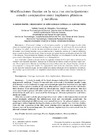Identificador persistente para citar o vincular este elemento:
https://accedacris.ulpgc.es/jspui/handle/10553/74055
| Campo DC | Valor | idioma |
|---|---|---|
| dc.contributor.author | Garcés Martín, Gerardo | en_US |
| dc.contributor.author | Múgica Garay, I. | en_US |
| dc.contributor.author | López González Coviella, N. | en_US |
| dc.contributor.author | Guerado Parra, Enrique | en_US |
| dc.date.accessioned | 2020-08-09T18:15:38Z | - |
| dc.date.available | 2020-08-09T18:15:38Z | - |
| dc.date.issued | 1991 | en_US |
| dc.identifier.issn | 0304-5056 | en_US |
| dc.identifier.other | Dialnet | - |
| dc.identifier.uri | https://accedacris.ulpgc.es/handle/10553/74055 | - |
| dc.description.abstract | El presente trabajo se efectuó para estudiar las modificaciones locales inducidas por implantes que atraviesan el cartílago de crecimiento. Se utilizaron 20 ratas macho de 5 semanas de edad. A través de una incisión parapatelar externa se insertó una aguja de Kirschner en el fémur derecho y una de plástico en el izquierdo, ambas de 1 mm de diámetro, atravesando la placa fisaria distal. Cinco animales por grupo fueron sacrificados al cabo de 1,2,8 y 16 semanas. Tras denudar los fémures de partes blandas, su extremidad distal fue procesada para estudio histológico, histomorfométrico e histoquímico. Los resultados demuestran que desde la segunda semana la fisis tuvo mayor altura en los fémures con implante metálico, aunque las diferencias no fueron estadísticamente significativas. No se apreciaron diferencias histológicas remarcables entre las placas fisarias con uno u otro implante a lo largo del estudio. La captación de azul alcián fue asimismo similar, salvo en la decimosexta semana en que fue marcadamente menor alrededor de los implantes metálicos. Se concluye que la naturaleza del implante condiciona las modificaciones fisarias inducida por éste. | en_US |
| dc.description.abstract | A study is made of the local changes induced by implants transversing growth cartilage. Twenty 5-week-old rats were used. A Kirschner needl e 1 mm. of diameter was introduced through an external parapatellar incision into the right femur, while a plastic needle of the same dimensions was passed into the left femur. Both needles wer e advanced until the distal physeal plates wer e pierced. The rats wer e sacrificed in groups of 5 after 1,2,8 and 16 weeks. After soft tissue removal, the distal femoral ends were processed for histological, histomorphometric and histochemical study. After the second week the physeal portions wer e taller in the femurs that received metal implants, although the differences were not statistically significant. No important histological differences wer e noted between the physeal plates corresponding to either implant during the study; alcian blue uptake was likewise similar, with the sole exception of the 16th week, during which uptake was markedly less intense around the metal implants. To conclude, implant type is seen to condition the physeal change s induced. | en_US |
| dc.language | spa | en_US |
| dc.relation.ispartof | Revista española de cirugía osteoarticular | en_US |
| dc.source | Revista española de cirugía osteoarticular [ISSN 0304-5056], v. 26 (155), p. 247-252 | en_US |
| dc.subject | 310910 Cirugía | en_US |
| dc.subject.other | Cartílago crecimiento | en_US |
| dc.subject.other | Fisis | en_US |
| dc.subject.other | Epifisiodesis | en_US |
| dc.subject.other | Osteosíntesis | en_US |
| dc.subject.other | Growth cartilage | en_US |
| dc.subject.other | Physis | en_US |
| dc.subject.other | Epiphysiodesis | en_US |
| dc.subject.other | Osteosynthesis | en_US |
| dc.title | Modificaciones fisarias en la rata tras enclavijamiento: estudio comparativo entre implantes plásticos y metálicos | en_US |
| dc.type | info:eu-repo/semantics/Article | en_US |
| dc.type | Article | en_US |
| dc.identifier.url | http://dialnet.unirioja.es/servlet/articulo?codigo=5509665 | - |
| dc.description.lastpage | 252 | en_US |
| dc.identifier.issue | 155 | - |
| dc.description.firstpage | 247 | en_US |
| dc.relation.volume | 26 | en_US |
| dc.investigacion | Ciencias de la Salud | en_US |
| dc.type2 | Artículo | en_US |
| dc.contributor.authordialnetid | 1615937 | - |
| dc.contributor.authordialnetid | 3945454 | - |
| dc.contributor.authordialnetid | No ID | - |
| dc.contributor.authordialnetid | No ID | - |
| dc.identifier.dialnet | 5509665ARTREV | - |
| dc.utils.revision | Sí | en_US |
| dc.identifier.ulpgc | Sí | es |
| item.fulltext | Con texto completo | - |
| item.grantfulltext | open | - |
| crisitem.author.dept | GIR Biomaterials and Biomechanics Research Group | - |
| crisitem.author.dept | Departamento de Ciencias Médicas y Quirúrgicas | - |
| crisitem.author.orcid | 0000-0003-4494-9077 | - |
| crisitem.author.parentorg | Departamento de Ingeniería Mecánica | - |
| crisitem.author.fullName | Garcés Martín, Gerardo | - |
| Colección: | Artículos | |
Visitas
190
actualizado el 15-ene-2026
Descargas
87
actualizado el 15-ene-2026
Google ScholarTM
Verifica
Comparte
Exporta metadatos
Los elementos en ULPGC accedaCRIS están protegidos por derechos de autor con todos los derechos reservados, a menos que se indique lo contrario.
